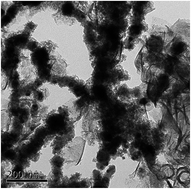Dechlorination of hexachlorobenzene by nano zero-valent iron/activated carbon composite: iron loading, kinetics and pathway†
Abstract
Nano zero-valent iron (nZVI) and activated carbon composites were synthesized and employed to remove hexachlorobenzene (HCB). Methods of impregnation and adsorption were employed to firstly load iron salt onto activated carbon, and thus loaded iron was then reduced to form zero valent iron. Results indicate that the method of iron loading significantly impacted the amount of iron and HCB dechlorination. In general, nZVI/activated carbon composite synthesized using an adsorption method showed considerably higher removal efficiency and dechlorination capability. More than 80% of the HCB was dechlorinated after 48 h. The dechlorination of HCB followed a stepwise pathway: HCB (hexachlorobenzene) → PCB (pentachlorobenzene) → 1,2,4,5 TeCB (tetrachlorobenzene) → TriCB (trichlorobenzene) → 1,4 DCB (dichlorobenzene) → MCB (monochlorobenzene). Compared with activated carbon or nZVI, nZVI/activated carbon composite showed much higher HCB removal. Analysis of mass partition on solid and aqueous phases indicates that most of the HCB and its dechlorination intermediates were retained on solids probably due to the strong adsorption on activated carbon. In summary, activated carbon performs three important functions: it alleviated the limitation of nZVI agglomeration, contributed to HCB removal due to its own adsorption capability and increased the resistance of nZVI against pH change.


 Please wait while we load your content...
Please wait while we load your content...